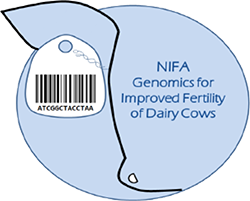Genomic Selection For Improved Fertility Of Dairy Cows With Emphasis On Cyclicity And Pregnancy
Fertility is a critical component of efficient dairy production, and failures to attain and maintain a timely pregnancy are major reasons for production losses in dairy herds. Consequences of low fertility include a reduced percentage of cows at the early stages of lactation, increments in insemination costs, and delayed genetic progress. Moreover, impaired fertility leading to low milk production has been reported as one of the most frequent reasons for culling. Historical trends show worsened reproductive parameters in the US.
The decline in fertility of dairy cows has been a concern for the dairy industry and has motivated profuse research in the last decades, and multiple variables have been identified as contributing factors to this condition. Development and implementation of genetic selection of dairy cattle has been the major method to improve productivity per animal; however, selection has been focused on production traits and only more recently reproduction and health traits. Current molecular technologies provide the opportunity for exploring genetic variation related to fertility. Identification of genetic markers related to fertility will lead to genetic progress to improve productivity.
Consequently, the overall objective of this integrated proposal is to make use of advanced genomic technologies to improve the efficiency of dairy animals for fertility traits through genomic selection. To achieve this objective, our aim is to identify genomic variation associated with direct measures of fertility in dairy cow populations (detection of estrus, pregnancy, pregnancy loss, and uterine health), and subsequently develop comprehensive extension and education programs that deliver science-based information to an extensive audience. It is our central hypothesis that reproduction in dairy cows is controlled, to some extent, by genetic components, and sufficient genetic variation for fertility traits exists in dairy cow populations to implement efficient selection programs.
The long-term goal of this integrated multistate project is to provide new resources for the understanding, and consequently, the improvement of dairy cattle fertility via identification of molecular markers significantly associated with reproductive efficiency. Our project will result in tools for selection of dairy cattle populations for improved fertility concurrent with increases in yields of milk and milk components, and our extension and education efforts will be used to better educate stakeholders and the public to promote sustainable dairy production for global food security.

